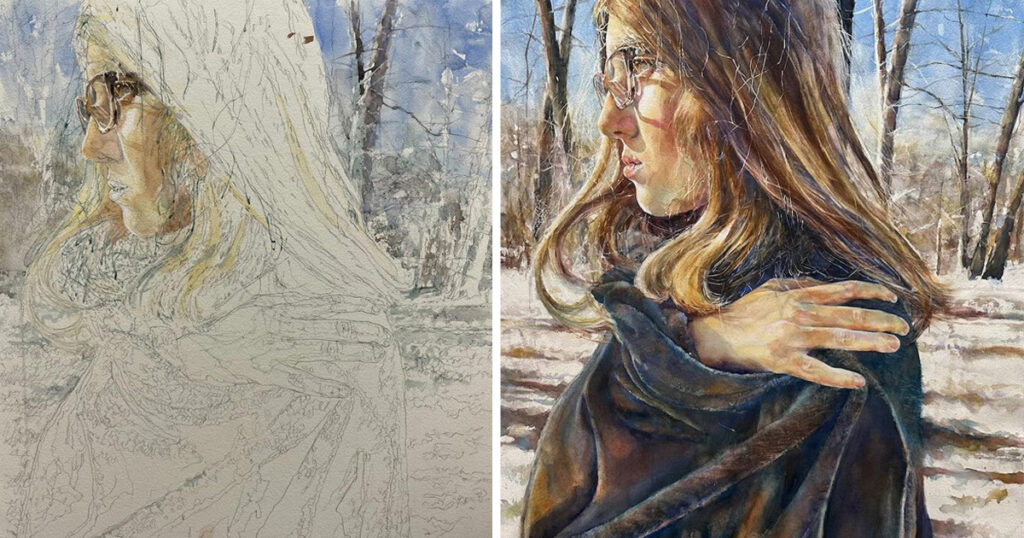Painting in Harmony

Perhaps nothing seems more natural than to paint water and water flowers in a water medium, where the paint’s fluidity complements the subject’s aquatic nature. The mingling and blending of wet-into-wet watercolor would fit perfectly in this scenario, but here the medium is dye and the support is silk. Drawing inspiration from a photograph taken in Beijing, China, Virginia Oehlke used realistic colors to create the subtle hues of the lotus flower and leaves in The Lotus Pond (dye, 20×28). The combination of these brilliant dyes with the silk fabric allowed Oehlke to capture the luminosity of the flower petals and present this age-old subject in a fresh way.
 Expressions on Silk: The Lotus Pond (dye, 20×28) by Virginia Oehlke.
Expressions on Silk: The Lotus Pond (dye, 20×28) by Virginia Oehlke.
Although there are several techniques that can be used in silk painting, typically you’ll stretch silk over a frame and apply dye to it with a brush. To control the movement of the dyes you can use a wax resist as Oehlke did, or you can use gutta or another water-based resist. Generally, the wax is applied with a tjanting, a tool with a reservoir for the hot wax and one or more spouts to direct the wax as it flows onto the silk. The heated wax sinks into the silk to form lines, such as in the white outlines of the leaves and flowers in The Lotus Pond.
Areas to Work On
To create a good composition, you typically need to utilize contrast. For instance, using contrasting colors or textures around your focal point can help lead the viewer’s eye to this area. But if you place too many contrasting colors or textures around your focal point, you’ll instead diminish its impact.
In The Lotus Pond, Oehlke has used contrasts in style and color transition that confuse the viewer. On the other hand, more contrast in the line work could better help the viewer. By paying better attention to these types of contrasts as she’s planning her composition, Oehlke could have created a more pleasing, peaceful picture.
Art Principles At Work
Varying line work. Using a resist in silk painting can be a great help in forming a design. Oehlke skillfully applied her lines of resist to draw the composition and to keep the areas of dye from running into one another. But these lines of resist appear too even and, consequently, boring. In addition, the outlined areas within the large foreground leaves create a puzzle-like effect, which draws the eye away from the center of interest, the flower. As well, the foreground leaves contrast too strongly with the background leaves, which breaks the serene mood of the painting.
We’ve found that uneven lines are attractive and more organic in silk painting, thus Oehlke doesn’t need to work so hard at making hers perfect. By varying the width of her lines of resist and the amount of line work used, she could have achieved a smoother transition along the background line and avoided the puzzle-like look.
Keeping a consistent style. Oehlke describes her paintings as realistic. But by outlining her foreground leaves and flowers, she created a stylistic look that contrasts with the realistically rendered flower and background leaves. Either look is attractive on its own, but combined they create a division in an otherwise peaceful painting.
Smoothing color transitions. Oehlke has used subtle transitions of light and dark colors throughout The Lotus Pond that add a sense of dimension to the flowers and the leaves. However, there’s a hard color separation between the subject and the dark blue background. To keep the background from looking disconnected from the middle ground, wed suggest that Oehlke add more blue to the lotus leaves. This carryover of color will help her achieve a smoother transition between these two areas.
Lessons Learned
By keeping her composition simple, Oehlke has created a strong framework for her painting. But the contrast of two different styles—realism in the flower and background leaves and a prism—like abstract in the main leaves—detracts from its overall appeal and mood. The placement of the foreground leaves is pleasing, but they don’t blend in with the rest of the piece.
Oehlke knows how to use her medium. With just a few alterations to her approach, such as varying the thickness of her resist lines and keeping her style consistent, she could create more expressive paintings.
About the Artist
“Don’t be afraid to make your art hobby into a career,” says Virginia Oehlke, a silk painter in Victoria, Texas. “As a result of having art-making as your full-time job, you’ll find yourself becoming more focused on improving your skills as an artist.” She’s won several local awards and had two one-person shows.
Diane Tuckman lives in Maryland and is the executive director of Silk Painters International (SPIN). New Mexico-based Jan Janas teaches silk painting around the country. Together they’ve written three books on silk painting.
MORE RESOURCES FOR ARTISTS
• Watch art workshops on demand at ArtistsNetwork.TV
• Online seminars for fine artists
• Instantly download fine art magazines, books, videos & more
• Sign up for your Artist’s Network email newsletter & receive a FREE ebook





Have a technical question?
Contact UsJoin the Conversation!